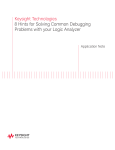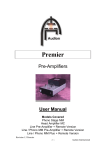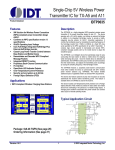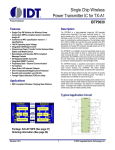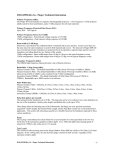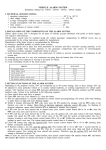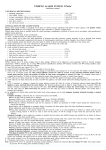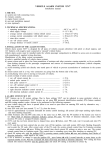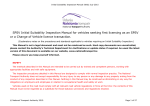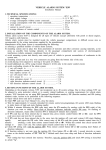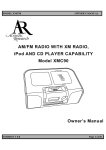Download Guidelines for Automotive Aftermarket Qi Chargers
Transcript
Guidelines for Automotive Aftermarket Qi Chargers Scope The purpose of this guideline is to assist developers and also to ensure that end users are not disappointed with a Qi automotive charger. This guideline is to apply to low power (5 watts or less) aftermarket automotive wireless powered transmitters and receivers. These guidelines will address safety, emissions and vehicle interface. By following these guidelines a product can bear the statement, “Meets Qi Automotive Aftermarket Guidelines”. Qi certified products do not have to comply with these guidelines but to bear the above statement products must be Qi certified and must comply with these guidelines. Compliance testing to these guidelines can be self-evaluated (no third party audit required). Automotive OEM products can also meet these guidelines but the individual OEM requirements will often exceed these guidelines. Installation and use instructions shall be included with the product. 2012/10/01 © The Wireless Power Consortium 2012 1/10 TABLE OF CONTENT 1 2 3 Changes List............................................................................................................................ 3 Introduction ............................................................................................................................. 4 Safety ...................................................................................................................................... 5 3.1 Foreign object detection: .................................................................................................. 5 3.2 Retention System for Transmitters and Receivers ........................................................... 5 3.2.1 Attachment of Transmitters in Automobiles............................................................. 5 3.2.2 Retention of Receivers to a Transmitter ................................................................... 5 3.2.3 Alignment Aids ......................................................................................................... 5 4 Emissions/Interferences .......................................................................................................... 6 4.1 Keyfob/Smart Key Interference ....................................................................................... 6 4.1.1 Location of Transmitter ............................................................................................ 6 4.1.2 Additional counter measures..................................................................................... 6 4.1.3 Charger shielding: ..................................................................................................... 7 4.1.4 Ping ........................................................................................................................... 7 4.2 Radio Interference AM/FM Band .................................................................................... 7 5 Vehicle Interface ..................................................................................................................... 8 5.1 Powered by Power Point .................................................................................................. 8 5.2 Dealer Installed-Hard Wired ............................................................................................ 8 6 Behaviour of Transmitter Under Extreme Temperatures ....................................................... 8 7 Charging Efficiency ................................................................................................................ 8 2012/10/01 © The Wireless Power Consortium 2012 2/10 1 CHANGES LIST Author Core AAG Version V1.0 Date June 1, 2012 Modification Creation document LeRoy Johnson V1.0 October 1, 2012 Made document non-confidential, added copyright information, and logo. 2012/10/01 © The Wireless Power Consortium 2012 3/10 2 Introduction Qi Products use wireless signals to send power from the Transmitter to the Receiver, and will often use other wireless signals (Ping) to detect the presence of a Receiver on the Transmitter. The frequency band of these wireless signals is between 110KHz and 205KHz. In an automotive system it is possible for the wireless signals generated by the Qi Transmitter to interfere with some of the systems within a car. Specifically key fobs used as an immobilizer or passive start system, AM/FM radios as well as tire pressure monitors. In practice most of the interference issues will be mitigated by careful placement of the transmitter, but some items may need to be considered during the development phase to ensure proper operation. 2012/10/01 © The Wireless Power Consortium 2012 4/10 3 Safety 3.1 Foreign object detection: An automotive aftermarket inductive charging system shall incorporate means for foreign object detection (FOD). The Qi Low Power Standard states in part 2, “A Base Station shall include at least one method to limit the temperature rise of Foreign Objects that are positioned on its Interface Surface.” Two such methods are covered by the Qi standard and are for power loss monitoring and temperature sensing. Please refer to the current Qi standards. 3.2 Retention System for Transmitters and Receivers 3.2.1 Attachment of Transmitters in Automobiles Manufacturers of automotive aftermarket transmitters shall include with the charger installation instructions that provide means for secure mounting. For proper mounting distances from other devices refer to section 4.1.1 of this guideline. 3.2.2 Retention of Receivers to a Transmitter Mechanical means should be provided to hold a device being charged from becoming a projectile under normal vehicle operation. Examples could be retention clips, charging area device cover or a recessed cavity. 3.2.3 Alignment Aids Alignment aids assist the mobile device user in finding the charging zone. At least one method should be utilized. Examples of these could be retention clips that hold the device while aligning the inductive coils, magnets, visual target zones, alignment lights or providing a clearly identified charging zone that has an array of transmitter coils or a self-aligning transmitter coil. 2012/10/01 © The Wireless Power Consortium 2012 5/10 4 Emissions/Interferences In addition to the OEM specifications and the standard regulations, the following recommendations should be respected in order to avoid problems with non-designedin aftermarket systems. 4.1 Keyfob/Smart Key Interference Interferences can occur at engine start, door opening and car lock. The user manual or product documentation, delivered with the charger, must explain that the charger may interfere with a key fob and that placement of the transmitter and key need to be considered to ensure good operation. 4.1.1 Location of Transmitter 4.1.1.1 Immobilizer system only The transmitter should be installed a safe distance (minimum 10 cm) away from the immobilizer system (i.e., steering lock or key fob docking station). 4.1.1.2 Passive start systems The transmitter should be installed a safe distance (minimum 10 cm) away from the immobilizer system (i.e., steering lock or key fob docking station). The transmitter should be installed at minimum 15 cm away from any possible layoff of the key fob, handbag or driver pockets. Ideal position is a vertical position on the dashboard. 4.1.2 Additional counter measures If the above mentioned safe recommended distances (4.1.1) can’t be achieved, other techniques are recommended to be used to avoid interference with the key fob. The charger installation and use instructions notes that the driver should insert the key fob into the charging slot whenever possible when operating the wireless charger. Charger should only be powered with “accessories” and/or “engine on” (can’t be applied with permanent powered cigarette lighters). To have some margin in timing between key fob authentication and contact/engine on, the charger should wait a minimum of one second before starting charge. With these measures the engine start and car lock problems can be avoided. Door opening or key fob polling with running engine remain a risk. 2012/10/01 © The Wireless Power Consortium 2012 6/10 4.1.3 Charger shielding: In addition to 4.1.1 and 4.1.2, X&Y shielding is recommended and mandatory if one of previous points is not respected. Z-shielding is not possible, but a key fob on the phone device is less probable. 4.1.4 Ping There is a possibility that the ping can be heard in the radio. This can be avoided by an alternative method to sense the phone presence (i.e., capacitive, optical, push button). 4.2 Radio Interference AM/FM Band Most radio systems have today the antenna either on the roof or printed on the rear window. For these cases the risk is reduced. Nevertheless, for other systems or for cabriolets or convertibles, some testing is required case by case before installing. 2012/10/01 © The Wireless Power Consortium 2012 7/10 5 Vehicle Interface Vehicle powered transmitters shall be designed to accept input voltages between 9 to 16VDC and may provide for 5VDC USB charge connections. Wiring must be done in a manner that prevents damage to the conductors. 5.1 Powered by Power Point Transmitters may be powered by means of a vehicle power point (cigarette lighter) plug. Fusing is required at the plug end of the power connection. Transmitters may be powered by means of a USB power source. Cable length should be appropriate for the recommended installation location in the vehicle. 5.2 Dealer Installed-Hard Wired Transmitters may be powered by means of a vehicle hard wired installation. Fusing is required for a dealer installation and may be done at the vehicle fuse block or power distribution bus. The transmitter should be wired so that it is powered when accessories are powered and not all the time. Wiring must be routed in such a way that it is not easily damaged by normal vehicle use and by entrance/egress of drivers and passengers. 2012/10/01 © The Wireless Power Consortium 2012 8/10 6 Behaviour of Transmitter under Extreme Temperatures Transmitters are expected to be installed in the passenger compartment of the automotive vehicle. The installation and use instructions that accompany the charger should have any temperature range limitations noted. 2012/10/01 © The Wireless Power Consortium 2012 9/10 7 Charging Efficiency Charging efficiency should be the same as all other Qi certified products. 2012/10/01 © The Wireless Power Consortium 2012 10/10










